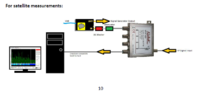The best and cheapest way is to download and read the user manuals of professional meters! That costs you nothing at all and often they do explain what a given functionality is used for.
Some manufacturers offer technical documentaion, too.
Search for user manuals, as well as, generic documentation relative to the following search words: DVB, spectrum analyser, constellation diagram, echo measurement, BER, MER, C/N, etc.
Good brands to look for documentation: Rover Instruments, Unaohm, Promax, KWS, Kathrein, Rohde & Schwarz, Anritsu, JDSU, VeEX, etc.
Another thing you can do, to avoid spending too much money, is to purchase a CRAZYSCAN compatible DVB-S2 card for your PC (
CrazyScan / Wiki / Info). This allows to render a non-realtime spectrum and then do an automatic transponder lock, without knowing the parameters. A great software that uses the CrazyScan DLL is EBSPro, which is now freeware (
EBSpro – The DXer's dream come true!). CrazyScan works with DVB-C and DVB-T cards, too.
Once you are familiar with all this, you can start hunting on eBay for an older field meter with real time spectrum analyser. Don't worry too much about the remaining functionality - if you want an up to date device, you will quickly spend a few thousands.
Regards,
Vitor


